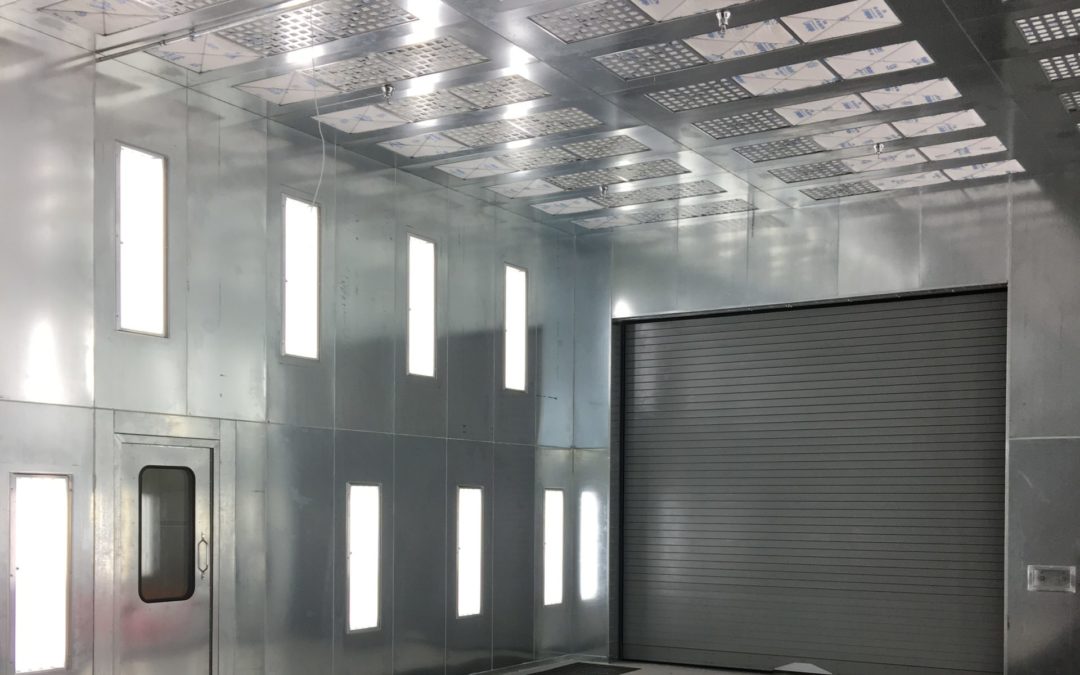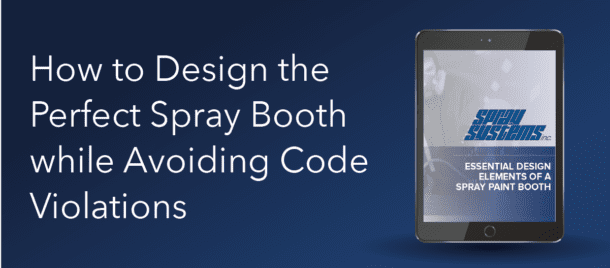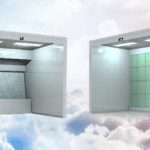Read Time: 5 minutes
Choosing the Right Filter for Paint Spray Booth Summary:
- Proper exhaust filtration for paint spray booths is mandated by law throughout the United States, with specific requirements varying by location and industry.
- Filtration systems, including intake, exhaust and air makeup units are positioned for crossdraft or downdraft, depending on the product being finished.
- Developing an effective filtration strategy requires an understanding of all chemicals and materials involved, as well as the demands placed on each part of the system.
- Recording operational data to compare the costs and results of different filters is a good idea.
- A filter’s loft rating, design, depth and composition all affect your airflow’s output as well as your maintenance costs
Spray paint booths allow for perfect finishing in isolated, clean spaces by using controlled airflow. While moving the required airflow, the booth must have the ability to prevent paint particles from being released into the atmosphere. Filters are the mechanism that bears the brunt of this important requirement and their importance cannot be understated.
Workplace and environmental safety aren’t the only reasons operators should care about picking the right filters for spray booths. Effective filtration of the fresh air into the booth also has a significant impact on the profitability and yield of the entire production process. Blocking potential contaminants from going into the booth is crucial for acceptable results with delicate projects.
While cheaper systems might cost less initially, a high-quality filter can last much longer, require less maintenance from workers and prevent the repercussions of environmental noncompliance.
Paint Spray Booth Airflow Basics
Spray booths are defined by the pattern of airflow through the interior of the unit, and each type utilizes different types of filters. Crossdraft models typically draw air through the front and exhaust air in the rear, forcing the flow horizontally through the chamber and taking particles of paint with it. Downdraft designs draw air in through the ceiling of the booth, allowing air to pass around the object being finished and down through a grate in the center of the floor.
Most airflow management systems for spray booths include:
- Intake filters
- Exhaust filters
- Air Makeup units
Let’s explore the functions of each and how to select the best options for your booth.
Intake Filters
As their name suggests, intake filters, also called supply filters, are positioned to cleanse the air that enters the booth. Even a small amount of dust or other debris can contaminate the spraying process, forcing expensive repairs and wasting company resources. The main features that operators look for in intake filters is the rate that air can pass through the material and its ability to reliably filter extremely small particles.
Spray Systems’ supply filters contain a high-performance cover mat with a filter of progressively structured media, thermally bonded and treated with a special adhesive tackifier. The combination of these features provides 95% efficiency in trapping any particles larger than 10 microns.
Exhaust Filters
Exhaust filters are located at the exhaust end of the booth near the exhaust fan, trapping paint overspray particles. The filters protect workers inside and outside the booth, as well as the local environment around the workplace from being exposed to paint overspray. These systems are mandated by the National Emission Standards for Hazardous Air Pollutants (NESHAP).
Spray Systems’ exhaust filters are made from a continuous filament glass fiber with an open weave pattern, preventing face-loading as the filter becomes saturated. This design forces paint-laden air to change direction many times as it passes through the filter, preventing fogging around the exhaust fan.
The design and material composition of exhaust filters should be chosen based on the nature of the specific paint material being used in the booth. Operators in the aerospace industry often choose NESHAP-approved three-stage filters, which are multi-stage exhaust filtration systems, although single-stage systems are a common choice across the market.
Air Makeup Units
Many booths are equipped with air makeup units (AMUs) that help maintain an even balance of air pressure inside and outside the booth. Industrial dry filter booths, for example, require relatively large exhaust volumes, which can be supplied from a direct gas-fired AMU system that replenishes the air in the booth that is being exhausted. The larger the booth, the more air that needs to be supplied.
As air is forced into the booths and then pulled out through the exhaust filter, the AMU ensures the interior of the booth remains in optimum condition for finishing. The filters in these units are a primary line of defense against air supply contamination. They are often the first filters to require replacement, cleaning or other maintenance during sustained booth use.
Creating a Filtration Strategy
Ultimately, there are three priorities when selecting the best filters for a spray booth: ensuring compliance, improving workplace safety and increasing profitability. Operators need to make sure that their workplace is in full compliance while looking for ways to cut costs and increase the quality of the results. Understanding the true cost of this decision can be particularly challenging, as there are dozens of factors that can influence the outcome.
Before exploring the various filter designs and materials available, operators should carefully analyze their production processes and standards. Fine-tuning your booth design can require some trial and error, so it’s a good idea to actively record all operational data to compare the costs and results of different filters. Developing an effective filtration strategy requires a firm grasp of the properties of all chemicals and materials involved, as well as the demands placed on each part of the system.
Things to Consider When Choosing a Paint Spray Booth Filter
Aside from making sure you select a filter that is compliant with industry regulations and is compatible with the manufacturer’s specifications of your paint booth, there are a few additional qualities you will want to look for in choosing the perfect spray booth filter for your operations. This will ensure your finishers are protected from harmful contaminants and your filter is suitable for providing the adequate airflow needed for your equipment as well as a flawless coat.
Filter qualities to consider:
- The grams and thickness of the filter
- The loft rating
- The materials the filter is comprised of
- The filter’s design in reference to how it affects maintenance costs/efficiency
- The adequate size specs needed
Choosing the Right Filtration for Your Spray Booth
Proper intake and exhaust mechanisms are necessary for quality finishing – and filtration systems are mandated by law throughout the United States, with specific minimum requirements varying by location and industry.
Ultimately, the right filter is the one that best suits the needs of the individual operator. Operators who are unfamiliar with spray booth technology can feel overwhelmed as they approach the topic of filtration. Spray Systems offers the benefit of our insight and experience to assist customers in designing the most effective comprehensive spray booth solution possible. We help our customers understand the essentials of their booths so they can find ways to improve their overall productivity and workplace safety.
Please feel free to contact us with any questions you have about selecting your next booth filter.


